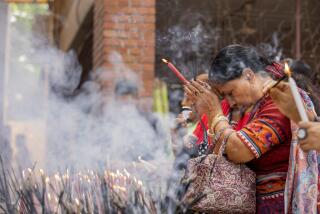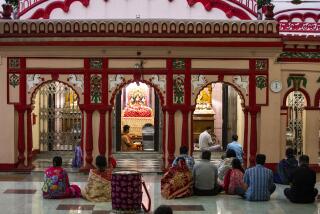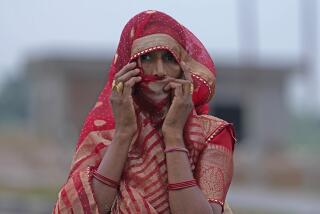Hindus Storm Mosque; 32 Die in India Strife
AYODHYA, India — More than 15,000 militant Hindu pilgrims stormed a disputed 16th-Century mosque here Tuesday, and those who managed to break through a police cordon began demolishing the Muslim shrine in an outbreak of religious violence that quickly spread nationwide.
The incident triggered Hindu-Muslim clashes in other parts of the country, leaving at least 32 dead, and pushed India closer to the brink of religious war. Within hours, Prime Minister Vishwanath Pratap Singh offered to resign over the controversy.
“My conscience is clear that I have sacrificed the highest office for the cause of the unity of the country and the oppressed,” Singh said in his letter offering to resign--”the oppressed” being a reference to Hindu-dominated India’s minority Muslim community.
In an interview broadcast on state-run television Tuesday night, Singh declared that the controversy over the mosque is “the biggest challenge we have faced since the independence of the country.” He added that his government has faced the challenge “admirably,” but he gave no details of Tuesday’s confrontation.
Singh’s letter was addressed to the leadership of the ruling People’s Party, which is not likely to act on it for several days.
Singh clearly staked his office and the future of his 10-month-old government on his ability to guard the Ayodhya mosque, which Hindu fundamentalists claim is located on the birthplace of the legendary demigod Lord Rama.
Last week, the prime minister ordered the arrest of his government’s key coalition partner, the leader of a Hindu fundamentalist party, over the dispute, and the party retaliated by withdrawing the support that Singh needs to stay in power.
Hindu radicals claim that before building the mosque, the Mongol Emperor Baber destroyed a temple on the site marking Rama’s birthplace. Muslim leaders say no Hindu temple ever stood there, but over the years Hindus have taken over the site. In 1986, a court agreed that Hindus should be allowed to worship there.
The Hindu radicals had announced that on Tuesday, the mosque would be demolished and a temple put up there. To try to prevent the assault, Singh ordered the arrests of more than 100,000 Hindu fundamentalists and militant pilgrims nationwide and deployed tens of thousands of police and paramilitary troops throughout Ayodhya and its surrounding state of Uttar Pradesh.
But on Tuesday, some officers of the state’s overwhelmingly Hindu police force did little to stop the mobs of pilgrims, some of whom had walked for as many as 100 miles through rural fields and villages to evade Singh’s dragnet and reach Ayodhya.
At least five Hindu militants were killed in the assault on the shrine when police opened fire. One senior paramilitary officer at the mosque, however, told The Times that when the mob was about to break through into the mosque complex, he refused to implement shoot-to-kill orders issued by local civilian authorities.
“Why kill people when there is another way?” asked the officer, who is a Hindu commander of the Border Security Force, an elite Indian paramilitary group controlled by Singh’s central government in New Delhi. “Now, it’s time for the politicians to talk and settle this.”
Instead of shooting the demonstrators, many in the Border Security Force were ordered to fire tear-gas grenades into the mob. Nearly 100 of the thousands of chanting pilgrims who reached the outer barricades still managed to break through the main gate and into the mosque. Among the invaders was an elderly pilgrim who lost half his face when he was hit directly by a gas grenade.
Bleeding, choking, crying and shrieking “Lord, Lord Rama! Long live Rama!” most of the mob raced through the cloud of tear gas and into the shrine, where they began tearing away at the mosque, brick by brick.
“We’ll destroy this mosque and 3,000 more like it if we must to protect our Hindustan (Hindu nation),” a businessman screamed in English to a Times reporter who accompanied the mob into the shrine. He said he had walked nearly a third of the way to the site from his home in New Delhi, the nation’s capital, hundreds of miles away.
More than two dozen state riot police, all of them Hindus, stood by as the mob attacked the wall, the dome and finally the interior of the mosque. The demolition began by hand, as the Hindu militants ripped out wall bricks and wrought-iron window gratings with their bare hands. Among the mob were middle-class Hindus as well as naked sadhus (holy men), all of whom had worked themselves into a frenzy in their battles with police.
Throughout the mayhem, the militants continually rang the temple bell, and Hindu holy men just outside the mosque chanted and played drums and cymbals.
It was not until after senior civilian officials arrived on the scene, about 15 minutes after the mosque was invaded, that the riot police were mobilized and the compound was quickly cleared.
“How did they get in here?” an angry Commissioner Madhukar Gupta, the senior civilian administrator in the region, asked a paramilitary officer when he arrived on the scene. The officer shrugged.
“Well,” said Gupta, “get them out--now.”
When the smoke and the sadhus were gone, the mosque floor was littered with broken bricks and concrete and stained with blood, and the outer walls were gouged and scarred.
Later, at a press conference in New Delhi, Prime Minister Singh’s home affairs minister, Mufti Mohammed Sayeed, who is Muslim, tried to defuse the nationwide religious tension by minimizing the event. He conceded that at least 15,000 pilgrims had penetrated the cordon around Ayodhya, but he asserted that only “two or three” managed to reach the mosque itself, and he said the site was wholly undamaged.
To most observers here, the attack on the mosque symbolized both the government’s failure to keep religious peace and the sheer force of the grass-roots Hindu fundamentalist movement that has swept much of India.
“Today is a watershed,” declared Yogi Aggarwal, a prominent Bombay journalist and political analyst after he witnessed the assault on the shrine. “From this day on, India can no longer claim to be a secular state. All the machinery of the state has failed to stop this thing, and I’m afraid this is only the beginning of a very troubled time for us.”
Already, the sponsors and participants of the event have claimed victory. “We Hindus have won a great victory in the battle today,” was a typical declaration heard from a cross section of Hindus--lawyers, business leaders, old village women, journalists.
From his bed at Ayodhya’s Sri Ram (Lord Rama) Hospital, where he was recovering from a minor head wound he received during the morning clashes with police, a leader of the movement to tear down the mosque and replace it with a Hindu temple said the day was a great success for the Hindu revivalist movement.
“The significance is, the Hindus cannot be taken for granted in this country anymore,” declared Ashok Singhal, general secretary of the World Hindu Council. “Until now, the national politicians have all been appeasing the Muslims only for their votes. Now, it has all exploded.
“Neither the politicians nor the administration can give them (India’s Muslims) any assurance or guarantee of security. Their security will depend only upon the relations with the Hindus . . . and they (the Muslims) only know the language of force.”
Meanwhile, Uttar Pradesh and several other states remained under army curfew after mobs had turned out to block major highways with burning tires and felled trees.
Although armed only with stones, bricks and sticks, the Hindu militants often managed to battle riot police into standoffs. And in some encounters, it was clear that the police officers were little more than observers, if not actual partisans.
In India, a land of at least 100 million Muslims and 700 million Hindus, the state police forces are the front lines of the civilian administration. But, near the mosque site in Ayodhya on Tuesday, reporters witnessed police removing barricades for the militant Hindus or simply standing aside while they passed, often chanting gleefully a Hindi-language rhyme that translates: “Isn’t it great? The police are with us.”
In only three confrontations, it appeared, did the police obey direct orders to open fire on the mob outside the mosque, resulting in the five deaths. Many others were killed elsewhere in the country during clashes between Muslims and Hindus reacting to the mosque assault.
In Ayodhya, civilian officials quickly realized that they had grossly miscalculated the fundamentalists’ determination to replace the mosque with a temple.
“We, very frankly speaking, got caught by surprise,” Commissioner Gupta told The Times at daybreak after riot troops drove off the first assault force of more than 5,000 pilgrims who pushed through police lines on a main bridge leading into the heart of Ayodhya. “We did not expect this large of a crowd to come here.”
And on the eve of what the Hindus were terming the “ceremony” at the mosque, a senior Indian official in the state capital of Lucknow had confided: “If it’s a crowd of 15,000 or 20,000 people there in Ayodhya, it’s a very serious situation, not only for us but for the entire nation. It means we totally misjudged the situation and the sentiment.”
Another senior civilian official here insisted that the confrontation is at least as much a political as a religious issue.
“Politics is very much there,” he said. “The politicians in power now are unable to come to terms with each other, so everyone is using the religious sentiments to try to gain the advantage--the prime minister by banking on the Muslim vote and his opponents by trying to build a new Hindu vote.
“Hinduism by definition is secular. It embraces all religions,” the official continued. “I just hope that what the country is witnessing now is not a redefinition of Hinduism itself.”
More to Read
Sign up for Essential California
The most important California stories and recommendations in your inbox every morning.
You may occasionally receive promotional content from the Los Angeles Times.










